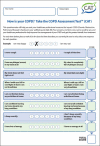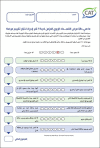The Saudi Guidelines for the Diagnosis and Management of COPD
- PMID: 24791168
- PMCID: PMC4005164
- DOI: 10.4103/1817-1737.128843
The Saudi Guidelines for the Diagnosis and Management of COPD
Abstract
The Saudi Thoracic Society (STS) launched the Saudi Initiative for Chronic Airway Diseases (SICAD) to develop a guideline for the diagnosis and management of chronic obstructive pulmonary disease (COPD). This guideline is primarily aimed for internists and general practitioners. Though there is scanty epidemiological data related to COPD, the SICAD panel believes that COPD prevalence is increasing in Saudi Arabia due to increasing prevalence of tobacco smoking among men and women. To overcome the issue of underutilization of spirometry for diagnosing COPD, handheld spirometry is recommended to screen individuals at risk for COPD. A unique feature about this guideline is the simplified practical approach to classify COPD into three classes based on the symptoms as per COPD Assessment Test (CAT) and the risk of exacerbations and hospitalization. Those patients with low risk of exacerbation (<2 in the past year) can be classified as either Class I when they have less symptoms (CAT < 10) or Class II when they have more symptoms (CAT ≥ 10). High-risk COPD patients, as manifested with ≥2 exacerbation or hospitalization in the past year irrespective of the baseline symptoms, are classified as Class III. Class I and II patients require bronchodilators for symptom relief, while Class III patients are recommended to use medications that reduce the risks of exacerbations. The guideline recommends screening for co-morbidities and suggests a comprehensive management approach including pulmonary rehabilitation for those with a CAT score ≥10. The article also discusses the diagnosis and management of acute exacerbations in COPD.
Keywords: Chronic bronchitis; Saudi Arabia; chronic obstructive pulmonary disease; emphysema; guidelines.
Conflict of interest statement
Figures
References
-
- Lopez AD, Shibuya K, Rao C, Mathers CD, Hansell AL, Held LS, et al. Chronic obstructive pulmonary disease: Current burden and future projections. Eur Respir J. 2006;27:397–412. - PubMed
-
- Menezes AM, Perez-Padilla R, Jardim JR, Muino A, Lopez MV, Valdivia G, et al. Chronic obstructive pulmonary disease in five Latin American cities (the PLATINO study): A prevalence study. Lancet. 2005;366:1875–81. - PubMed
-
- Pena VS, Miravitlles M, Gabriel R, Jimenez-Ruiz CA, Villasante C, Masa JF, et al. Geographic variations in prevalence and underdiagnosis of COPD: Results of the IBERPOC multicentre epidemiological study. Chest. 2000;118:981–9. - PubMed
-
- Pride NB, Soriano JB. Chronic obstructive pulmonary disease in the United Kingdom: Trends in mortality, morbidity, and smoking. Current opinion in pulmonary medicine. 2002;8:95–101. - PubMed
LinkOut - more resources
Full Text Sources
Other Literature Sources
Miscellaneous




